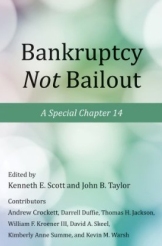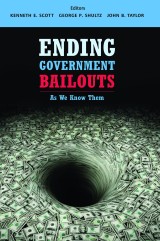David Skeel and I wrote the following on an important report on bankruptcy reform just released by the U.S. Treasury:
Yesterday the U.S. Treasury released its official response to President Trump’s memorandum of last April asking for a review of whether an improved bankruptcy law “would be a superior method for the resolution of financial companies” compared to the regulator-run resolution process embodied in the Dodd-Frank Act. After a year of hearings, consultations, and study, Report to the President on Orderly Liquidation Authority and Bankruptcy Reform states “unequivocally” that bankruptcy should be the preferred method of resolution.  The Report calls for a “more robust, effective, bankruptcy process for financial companies” along the lines of the “Chapter 14” proposal of the Hoover Institution Resolution Project, of which we are members, now written into legislation making its way through the House and Senate.
The Report calls for a “more robust, effective, bankruptcy process for financial companies” along the lines of the “Chapter 14” proposal of the Hoover Institution Resolution Project, of which we are members, now written into legislation making its way through the House and Senate.
Through careful analysis and judgment of which reform is likely to work politically, financially, and internationally, the Report provides a practical road map to get the legislation passed. Chapter 14, so called because there is now no Chapter 14 in the bankruptcy code, would rely on the rule of law and strict priority rules of bankruptcy, but would operate faster than current law—over a weekend—leaving operating subsidiaries outside of bankruptcy entirely. After filing for Chapter 14, the parent company would transfer its operations and short-term debt to a newly created bridge company that is not in bankruptcy. The bridge company would be recapitalized and ready to continue operations, while the long-term unsecured debt and stock would be left behind in the old company. The old company would go through bankruptcy in a predictable, rules-based manner without harming the financial system or the economy.

The Report concludes that the Orderly Liquidation Authority (OLA), as the current resolution process under the Dodd-Frank Act is known, “confers far too much unchecked administrative discretion, could be misused to bail out creditors, and runs the risk of weakening market discipline.” A particularly glaring flaw is the absence of clear priority rules: as receiver for the distressed financial company, the Federal Deposit Insurance Corporation is permitted to pick and choose which creditors are paid first. The Report urges the FDIC to commit to honoring the ordinary priority rules in OLA, to make it more rule-like and predictable.
OLA also gives the FDIC access to vast amounts of funding from the U.S. Treasury, which critics worry could function like a bailout. The Report calls for much tighter constraints on the use of the funding. The loans should be secured by good collateral, and should require substantial interest payments, in keeping with the classic approach for providing liquidity to a distressed financial institution. For similar reasons, the Report takes aim at a provision that gives tax exempt status to any bridge institution that is formed for the purposes of an OLA resolution. There is no justification for this special treatment, and the Report rightly calls for its removal.

This “reform rather than repeal” approach to OLA leaves in place international arrangements through which resolution authorities in different countries can coordinate the resolution of large international financial firms. If OLA were repealed, there would be no parallel authority in the United States. Moreover, with Chapter 14 in place, the resolution planning process required by other provisions of the Dodd-Frank Act would work better, because large institutions could credibly outline how their distress would be handled in bankruptcy. Some of the resolution plans submitted by the large financial firms have been rejected by Fed and FDIC.
The Report adopts a middle ground with respect to regulators’ role in the Chapter 14 process. Unlike OLA, which gives regulators’ complete control, the managers of the troubled company would be the ones to file the Chapter 14 case. Although our Hoover group recommended that either the company or regulators be permitted to file, the Report worries that regulators and a troubled financial company might engage in a game of chicken if both had the power to file. The Report would not exclude regulators from the filing decision, however. It would encourage judicial deference to a Federal Reserve determination that the Chapter 14 transaction should be approved.
The Report, like the versions of Chapter 14 currently pending in Congress, would not provide any government funding of the resolution process. Although we have advocated access to limited governmental financing, the Report rightly recognizes that Chapter 14 would require much less new funding than a more complex and time consuming resolution framework. Because the new bridge company would be fully solvent, having left most of its debt behind, private lenders are likely to be willing to provide any necessary new funding.
If Chapter 14 were added to the bankruptcy code, it would become the strategy of choice for resolving the financial distress of large financial institutions. OLA would still be available as an alternative, but it would rarely if ever be needed.
Bankruptcy reform is an essential element of an economic growth program. The reform makes failure feasible under clear rules without disruptive spillovers. It would help prevent bailouts, diminish excessive risk-taking, remove uncertainty associated with an ad hoc bailout process, and reduce the likelihood and severity of financial crises. Research by our colleague Emily Kapur shows the new law might have prevented the contagion associated with the failure of Lehman Brothers in 2008.
The Administration has laid out a clear path to ending too big to fail and making the financial system more resilient. Now is the time to move forward and get the job done.



